Al Gore "An Inconvenient Truth"

Al Gore "An Inconvenient Truth" |
 |
Part 4 (42:06 - 49:44) |
|
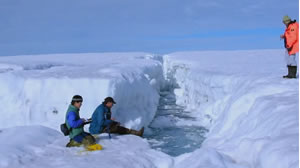 |
A Canary in the Coal Mine: The Arctic Two canaries in the coal mine. The first one is in the Arctic. Of course, the Arctic Ocean has a floating ice cap, Greenland on its side there. I say canary in the coal mine because the Arctic is one one of the two regions of the world that is experiencing faster impact from global warming. This is the largest ice shelf in the Arctic, the Ward Hunt Ice Shelf. It just cracked in half a year ago. The scientists were astonished. |
Melting Permafrost |
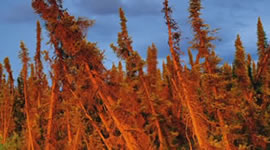 These are called drunken trees just going every which way. This is not caused by wind damage or alcohol consumption. These trees put their roots down in the permafrost and the permafrost is thawing, so they just go every which way now. These are called drunken trees just going every which way. This is not caused by wind damage or alcohol consumption. These trees put their roots down in the permafrost and the permafrost is thawing, so they just go every which way now. |
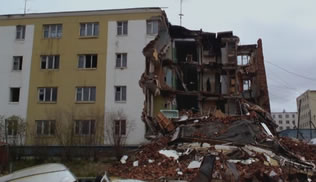 This building was built on the permafrost and collapsed as the permafrost thawed. This building was built on the permafrost and collapsed as the permafrost thawed. |
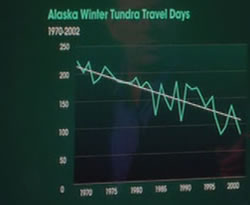
The pipeline is suffering a great deal of structural damage. Incidentally, the oil that they want to produce in that protected area in northern Alaska, which I hope they don’t. They have to depend on trucks to go in and out of there and the trucks go over the frozen ground. This shows the number of days that the tundra in Alaska is frozen enough to drive on it. 35 years ago it was 225 days a year. Now it’s below 75 days a year because the spring comes earlier and the fall comes later and the temperatures just keep on going up. |
|
Fastest Temperature Increase Occurs at the Arctic I went up to the North Pole. I went under that ice cap in a nuclear submarine that surfaced through the ice like this. This thing started patrolling in 1957. They have gone under the ice and measured with their radar looking upward to measure how thick it is, because they can only surface where the thickness of the ice is 3 and half feet thick or less. So they have kept a meticulous record and they wouldn’t release because it was national security. I went up there in order to persuade them to release them, and they did. And here’s what that record showed. Starting in 1970 there was a precipitous drop off in the amount and extent and thickness of the arctic ice cap. It has diminished by 40 percent in 40 years. There are two major studies showing that in the next 50 or 70 years in summertime it will be completely gone. |
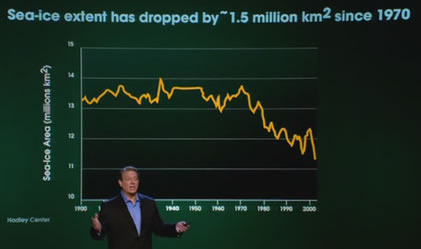 |
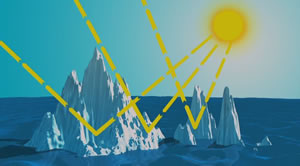 |
Now you might say, “Why is that a problem? How could the arctic ice cap actually melt so quickly?” When the sun’s rays hit the ice, more than 90 percent of it bounces off right back into space like a mirror. But when it hits the open ocean, more than 90 percent is absorbed. As the surrounding water gets warmer, it speeds up the melting of the ice. Right now the arctic ice cap acts like a giant mirror. All the sun’s rays bounce off, more than 90 percent, to keep the earth cooler. But as it melts and the open ocean receives that sun’s energy instead more than 90 percent is absorbed. So there is a faster build up of heat here at the North Pole in the Arctic Ocean and the Arctic generally than any where else on the planet. That’s not good for creatures like polar bears, who depend on the ice. A new scientific study shows that for the first time they’re finding polar bears that have actually drowned, swimming long distances up to 60 miles to find the ice. They did not find that before. What does it mean to us to look at vast expanse of open water at the top of our world that used to be covered by ice? We ought to care a lot because it has planetary effects. |
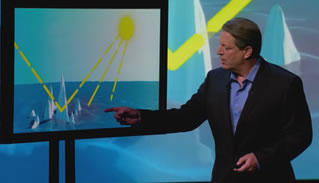 |
Earth’s Climate is an Engine On a worldwide basis the annual average temperature is about 58 degrees Fahrenheit (15 degrees Celsius). If we have an increase of 5 degrees (about 1,2o C), which is on the low end of the projections, look at how that translates globally. That means an increase of only 1 degree at the equator but more than 12 degrees at the poles. So all those wind and ocean current patterns that have formed since the last ice age and have been relatively stable, they are all up in the air and they change. |
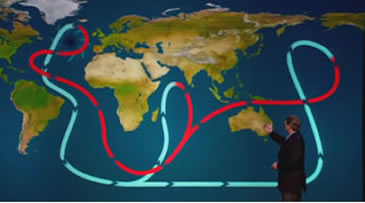 |
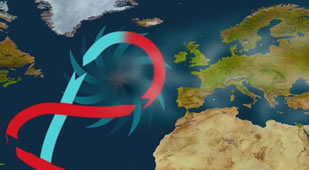 |
And one of the ones they are most worried about, where they have spent a lot of time studying the problem is in the North Atlantic, where the Gulf Stream comes up and meets the cold winds coming off the arctic over Greenland and evaporates the heat out of the Gulf Stream and the stream is carried over to western Europe by the prevailing winds and the Earth’s rotation. But isn’t it interesting that the whole ocean current system is all linked together in this loop? They call it the ocean conveyor. The red are the warm surface current, the Gulf Stream is the best known of them. The blue represent the cold currents running in the opposite direction. We don’t see them at all because they run along the bottom of the ocean. Up in the North Atlantic, after that heat is pulled out, what’s left behind is colder water and saltier water, because salt doesn’t go anywhere. That makes it denser and heavier. That cold, dense heavy water sinks at a rate of 5 billion gallons per second. That pulls that current back south. Disruption of the Ocean Conveyor At the end of the last ice age as the Vlad glacier was receding from North America, the ice melted and a giant pool of fresh water formed in North America. The Great Lakes are the remnants of that huge lake. An ice dam on the eastern border formed, and one day it broke. All that fresh water came rushing out, ripping open the St. Lawrence, there. It diluted the salty dense cold water, made it fresher and lighter so it stopped sinking. And that pump shut off and the heat transfer stopped, and Europe went back into an ice age for another 900 or 1000 years. The change from conditions like we have here today to an ice age took place in perhaps as little as 10 years time. That is a sudden jump. Of course, that’s not going to happen again, because the glaciers of North America are not there. Is there any big chunk of ice anywhere near there? Oh yeah, (pointing at Greenland). We’ll come back to that one. |
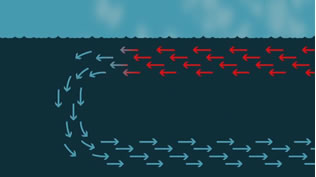 |
|
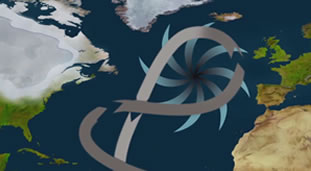 |